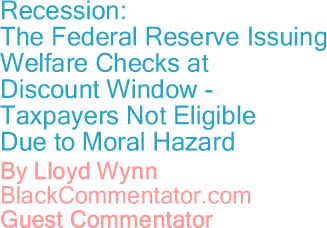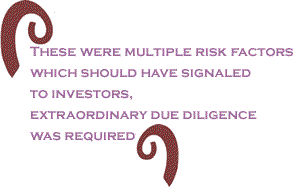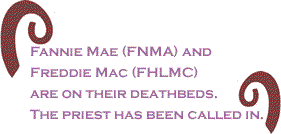
|
||||||||||||||||||||||
 |
||||||||||||||||||||||
 |
||||||||||||||||||||||
 |
||||||||||||||||||||||
 |
| The current issue is always free to everyone |
|
|
 |
 |
As you know, the financial sector of the economy
is in a crisis now, particularly in mortgage lending. Nothing
less than panic is rippling through financial markets the world
over. The fallout from nonprime lending has cascaded into other
segments of the global economy and what you are watching unfold
is the reaction to an overleveraged financial market held together
by bubblegum and scotch tape. According to Treasury Secretary
Paulson, the This conclusion is inconsistent with the conventional definition of recession but the alarm needs to sound early due to several important factors:
The president and likeminded economists claim they do not want to “talk down the economy” but when you look at the conditions of the marketplace and the actions of the Federal Reserve, it is difficult for any reasonable person to not conclude that we are traveling at an accelerated pace for an economic meltdown. The Federal Reserve’s (Fed) proposal to loan $200 billion to financial institutions, using mortgage-backed securities as collateral, in addition to the $180-plus billion from the previous 2 weeks is nothing short of a welfare check. The only difference is the recipients are wealthy White men instead of single moms. The mortgage backed securities the Fed is using as collateral are next to worthless on today’s market. Mortgage Backed Securities (MBS) are investment instruments consisting of mortgage loans. The mortgage loans are packaged (securitized) into securities and sold to investors. Payments to the investor will be made by the servicer (company collecting principal, interest and escrow payments) upon receiving the homeowners’ mortgage payments. Should the homeowner refinance or payoff the mortgage, that loan is replaced in the portfolio with another loan of similar characteristics--interest rate, pre-payment penalty, loan-to-value ratio, etc. What happens when there is a portfolio of 1,000 loans and 300 of the loans goes into foreclosure and/or the market value of 200 loans decrease by an average of 15%? This is not a hypothetical. The frequency in which these events (foreclosure or diminution in value) occur today has created a lack of confidence and instability in financial markets. To illustrate,
we will use one of Goldman
Sachs’ securities that is commonly referred to as one of those
horror deals for all parties involved, except Goldman Sachs.
In April, 2006, Goldman issued security GSAMP
Trust 2006-S3, which consisted of 8,274 second mortgage loans.
58% of the individual loans were underwritten to no doc and
low doc standards, meaning there were no proof of income or
employment and the average combined loan to value (cltv) was
99.29%; as a result, the average homeowner equity for this pool
was less than 1%. One-third of the loans came from
Late 2006 and the beginning of 2007, borrowers in general began to default on early payments (1st three payments) at a much higher rate than historical data indicated they would. The market value of homes was beginning to depreciate and interest rates were rising. Lenders and federal regulators started to impose stricter underwriting guidelines. As the second mortgage holder, GSAMP could not foreclose unless they paid off the first mortgage, thus if the borrower continued to pay their first mortgage, there was nothing GSAMP could do. Being in that position is the greatest risk a second mortgage holder faces - the inability to foreclose. In February of 2007, less than one year after the security was issued, Moody’s and Standard & Poors downgraded the Goldman security and only the top three tranches remained above the Junk grade. By the end of September, 2007, 18% of the loans in the GSAMP security had defaulted. This was bad news for those investors holding the bottom 7 tranches. The way these deals are structured, the investors with the greatest risk take the losses first. Those investors at the top are exposed to the risk (borrower going into default) last. Thus to the extent a borrower does not pay the loan back, those investors with the higher risk tranches are exposed first. Please Note: in an earlier paragraph where mortgage-backed securities was defined, I said if a loan is paid off or refinanced, it is replaced in the pool with a loan of similar quality, the caveat to that statement is the terms of the agreement between the issuer and the investor. By July, 2007, Standard & Poors had downgraded 418 securities collateralized by closed-end second mortgages originated between January, 2005 and January, 2007, for a total value of $62 billion. During this same period there were $2.5 trillion in private label first mortgages that were underwritten to similar standards. Private label is defined as non-agency loans or loans that are not underwritten to Fannie Mae (FNMA) or Freddie Mac (FHLMC) guidelines. The removal of a rating agency’s higher rating, not only results in asset-backed securities losing value in the marketplace but it shakes the investors’ confidence in that particular investment vehicle, decreasing demand which, in turn, puts downward pressure on the value of the asset. This cycle is repeated until the asset is almost worthless. So far, investment houses have written down approximately $160 billion in losses and counting, which brings us to the collapse of another fund owned by the Carlyle Group that has many layers to peel away. The Carlyle Group was started in 1987 by William
Conway, Daniel D’Aniello and David Rubenstein. Carlyle is a
global private equity firm with over $80 billion under management.
It is well-known for employing some very heavy hitters - both
Bush presidents, James Baker, former British prime minister,
John Major and a long list of others from the But the Carlyle Group has the reputation of having
“the Midas touch”. The firm has engineered many renown deals but two in particular are contrary to the Midas
touch reputation, Caterair, for which the president was affiliated
with before he became
The rapid decline in the value of mortgage-backed securities over the past 6 months forced lenders to issue a margin call (additional capital or assets as collateral for the transaction). The CCC received an addition $150 million from parent company, Carlyle Group. The market-value of the securities further declined and the lenders asked for an additional $400 million. Last week, the fund allegedly went into default and collapsed. Nothing more about it was forthcoming. The news no longer was about the Carlyle Group but headlines were the Federal Reserve (Fed) would make available $200 billion to member banks through its Discount Window and the Fed would take mortgage backed securities as collateral.
Shortly after the Fed’s announcement, Bear Stearns confirmed it was in trouble and was in negotiations with JP Morgan Chase to resolve their financial woes. Bear Stearns and the Carlyle Group could not take advantage of the welfare checks being disbursed at the Discount Window but JP Morgan Chase could. Thus, the fix was on. The Fed assured JP Morgan that it would not lose any money on the deal and pledged $30 billion to help JP Morgan if it should sustain any losses. The path has been cleared for the Carlyle Group and Bear Stearns to unload their worthless securities on the American taxpayer adding insult to injury. There is one other wrinkle to this Carlyle Group and BS (I do not mean Bear Stearns) saga. What you do not hear in the marketplace is Fannie Mae (FNMA) and Freddie Mac (FHLMC) are on their deathbeds. The priest has been called in. Succinctly, the Fed is trying to bailout Fannie and Freddie. On March 12, 2008, when all interested parties were notified by a well-known company which monitors mortgage-backed securities, that the value in mortgage-backed securities had diminished considerably, a principal at the Carlyle Group reported that Carlyle owns agency mortgage-backed securities, the implication being this type of security is backed by the full faith and credit of the US Government. After 40 years (Fannie became a stockholder-owned company in 1968) of rebuttals by government officials and that FNMA is not backed by the federal government, now the Fed has to reverse itself and bailout Fannie and Freddie because their operations are completely intertwined in the massive derivative crisis, tainted and just as toxic as all the other worthless mortgage-backed securities on the market. To Be Continued. BlackCommentator.com Guest Commentator, Lloyd Wynn was a consultant in the secondary market. Lloyd is the author of Residential Real Estate Finance: From Application Through Settlement. Click here to contact Lloyd Wynn.
|
Your comments are always welcome. e-Mail re-print notice
If you send us an e-Mail message we may publish all or part of it, unless you tell us it is not for publication. You may also request that we withhold your name. Thank you very much for your readership. |
|
| March 20, 2008 Issue 269 |
|
| Executive Editor: Bill Fletcher, Jr. |
| Publisher: Peter Gamble |
| Printer Friendly Version in resizeable plain text format format |
 |
 |
 |
| |
| |






















 If
I were to tell you Sen. Edwards is no longer seeking the Democratic
nomination for president you would probably stop reading here.
Old news right? Similarly, when one accepts the commonly used
definition for a recession (two consecutive quarters of negative
growth): that is old news. If we buy into that reasoning, we
will have to wait until July before we can determine if the
economy is in a recession. The definition is problematic since
it is based upon historical data rather than current conditions.
Besides, you do not want to wait for an Administration flaunting
its dubious record on productivity and low unemployment, to
tell you there is a recession. When I hear the president talk
about his administration’s achievements, I am reminded of an
enormously flawed and conflicted but brilliant American literary
figure who said, “[t]here are three kinds of lies: lies, damned
lies, and statistics”.
If
I were to tell you Sen. Edwards is no longer seeking the Democratic
nomination for president you would probably stop reading here.
Old news right? Similarly, when one accepts the commonly used
definition for a recession (two consecutive quarters of negative
growth): that is old news. If we buy into that reasoning, we
will have to wait until July before we can determine if the
economy is in a recession. The definition is problematic since
it is based upon historical data rather than current conditions.
Besides, you do not want to wait for an Administration flaunting
its dubious record on productivity and low unemployment, to
tell you there is a recession. When I hear the president talk
about his administration’s achievements, I am reminded of an
enormously flawed and conflicted but brilliant American literary
figure who said, “[t]here are three kinds of lies: lies, damned
lies, and statistics”. There
were 13 tanches in Goldman’s security and depending on what
the investor bought - AAA (prime) down to bb (canner or cutter
beef) - determined the amount of risk in the security. Investors
who purchased AAA tranches had less risk and the expected return
was less. Those investors who purchased the three tranches rated
as Junk expected to receive a higher return on their investment
because there were greater risk in those tranches (probably
all of the risk factors stated above, a lower credit score,
minimal reserves, none owner-occupied, etc.). The top three
tranches (prime) were sold for $336 million and the next 7 tranches
of varying grades were sold for $123 million. Morgan Keegan
High Growth Income Fund bought the $8 million non-investment
grade (Junk) tranche and the $13 million non-investment tranche
was purchased by UBS’ Absolute Return Fund, foreign investors.
Goldman kept the final $14 million non-investment grade tranche
for putting the deal together.
There
were 13 tanches in Goldman’s security and depending on what
the investor bought - AAA (prime) down to bb (canner or cutter
beef) - determined the amount of risk in the security. Investors
who purchased AAA tranches had less risk and the expected return
was less. Those investors who purchased the three tranches rated
as Junk expected to receive a higher return on their investment
because there were greater risk in those tranches (probably
all of the risk factors stated above, a lower credit score,
minimal reserves, none owner-occupied, etc.). The top three
tranches (prime) were sold for $336 million and the next 7 tranches
of varying grades were sold for $123 million. Morgan Keegan
High Growth Income Fund bought the $8 million non-investment
grade (Junk) tranche and the $13 million non-investment tranche
was purchased by UBS’ Absolute Return Fund, foreign investors.
Goldman kept the final $14 million non-investment grade tranche
for putting the deal together. 
 The
collapse of the $21.5 billion equity fund of CCC represents
one of hundreds of funds that went into default. The $160-plus
billion that was noted as being written off referenced only
that which has been taken off the balance sheets of investment
houses. We have a $6 trillion housing bubble that has burst
and now you will see many equity funds collapse, pensions will
be lost and insurance rates will increase. They invested in
the mortgage-backed securities and derivatives market and the
paper is worthless. There is no demand for mortgage-backed securities;
too many are on the market. Easy access and lowered cost have
not triggered demand in the marketplace for these instruments
because they are collateralized with mortgages. Homeowners are
not paying their mortgages because of the resets on adjustable
rate mortgages, they are upside down/underwater or they have
lost their job, accordingly, housing values continue to decline
as the foreclosures escalates.
The
collapse of the $21.5 billion equity fund of CCC represents
one of hundreds of funds that went into default. The $160-plus
billion that was noted as being written off referenced only
that which has been taken off the balance sheets of investment
houses. We have a $6 trillion housing bubble that has burst
and now you will see many equity funds collapse, pensions will
be lost and insurance rates will increase. They invested in
the mortgage-backed securities and derivatives market and the
paper is worthless. There is no demand for mortgage-backed securities;
too many are on the market. Easy access and lowered cost have
not triggered demand in the marketplace for these instruments
because they are collateralized with mortgages. Homeowners are
not paying their mortgages because of the resets on adjustable
rate mortgages, they are upside down/underwater or they have
lost their job, accordingly, housing values continue to decline
as the foreclosures escalates. There
had been rumors about Bear Stearns’ soundness because it was
so heavily invested in mortgage backed securities, agency and
non-agency. Unfortunately for Bear Stearns, they were not eligible
for the welfare checks the Feds were handing out at the Discount
Window. If it were eligible, Bear Stearns could dump their worthless
mortgage backed securities on the Fed (taxpayers) and participate
in the give-away that is free of the “moral hazard”. Only bailouts
for taxpayers represent moral hazards, presumably, investment
banks will not repeat this behavior.
There
had been rumors about Bear Stearns’ soundness because it was
so heavily invested in mortgage backed securities, agency and
non-agency. Unfortunately for Bear Stearns, they were not eligible
for the welfare checks the Feds were handing out at the Discount
Window. If it were eligible, Bear Stearns could dump their worthless
mortgage backed securities on the Fed (taxpayers) and participate
in the give-away that is free of the “moral hazard”. Only bailouts
for taxpayers represent moral hazards, presumably, investment
banks will not repeat this behavior.






